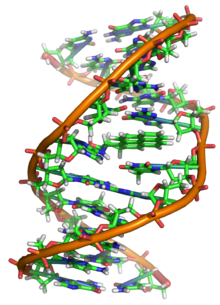DNA adduct


A DNA adduct is chemically modified DNA . DNA adducts are part of the DNA damage .
properties
DNA adducts are created by changing the DNA through various mutagens , such as B. the alkylating agents . A molecule is linked to a nucleotide in the DNA via a covalent bond . These modified nucleotides interfere with various subsequent reactions, such as a cell's DNA replication . Therefore, DNA adducts are recognized and largely repaired in the course of DNA repair. A tumor can develop in the event of faulty DNA repair in proto-oncogenes or tumor suppressor genes . The number of DNA adducts in a cell is a measure of exposure to carcinogens . Typical mutagens that lead to DNA adducts are e.g. B. safrol , benzpyrenediol epoxide , acetaldehyde , formaldehyde , vinyl chloride , ethylene oxide and peroxides of lipids and their reaction products ( malondialdehyde ). In one study, people who were found to have aflatoxin (AFB1-N7-G) DNA adducts had a 9.1-fold increased risk of developing liver cancer.
Individual evidence
- ^ JC Delaney, JM Essigmann: Biological properties of single chemical-DNA adducts: a twenty year perspective. In: Chemical research in toxicology. Volume 21, number 1, January 2008, pp. 232-252, doi : 10.1021 / tx700292a , PMID 18072751 , PMC 2821157 (free full text).
- ↑ M. Bichara, M. Meier, J. Wagner, A. Cordonnier, IB Lambert: Postreplication repair mechanisms in the presence of DNA Adducts in Escherichia coli. In: Mutation research. Volume 727, number 3, 2011 May-Jun, pp. 104-122, doi : 10.1016 / j.mrrev.2011.04.003 , PMID 21558018 .
- ↑ DK La, JA Swenberg: DNA adducts: biological markers of exposure and potential applications to risk assessment. In: Mutation research. Volume 365, Numbers 1-3, September 1996, pp. 129-146, PMID 8898994 .
- ↑ TR Rajalakshmi, N. AravindhaBabu, Shanmugam KT, KM Masthan: DNA Adducts-chemical add-ons. In: Journal of pharmacy & bioallied sciences. Volume 7, Suppl 1 April 2015, pp. S197 – S199, doi : 10.4103 / 0975-7406.155901 , PMID 26015708 , PMC 4439668 (free full text).
- ↑ JA Swenberg, K. Lu, BC Moeller, L. Gao, PB Upton, J. Nakamura, TB Starr: Endogenous versus exogenous DNA adducts: their role in carcinogenesis, epidemiology, and risk assessment. In: Toxicological sciences: an official journal of the Society of Toxicology. Volume 120 Suppl 1, March 2011, pp. S130-S145, doi : 10.1093 / toxsci / kfq371 , PMID 21163908 , PMC 3043087 (free full text).
- ↑ D. Pluskota-Karwatka: Modifications of nucleosides by endogenous mutagens-DNA adducts arising from cellular processes. In: Bioorganic Chemistry. Volume 36, Number 4, August 2008, pp. 198-213, doi : 10.1016 / j.bioorg.2008.04.002 , PMID 18561974 .
- ↑ MC Poirier: DNA adducts as exposure biomarkers and indicators of cancer risk . In: Environmental Health Perspectives . tape 105 , no. 4 , 1997, PMID 9255579 .